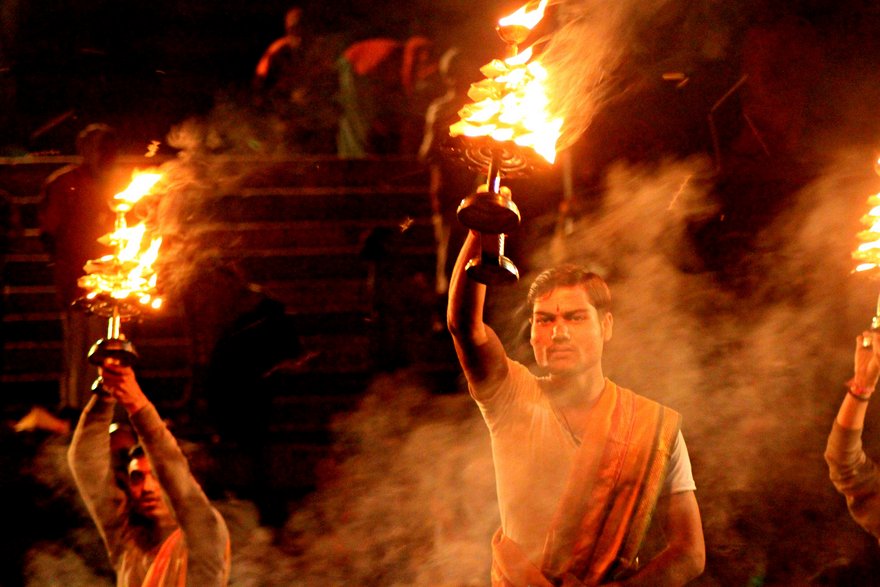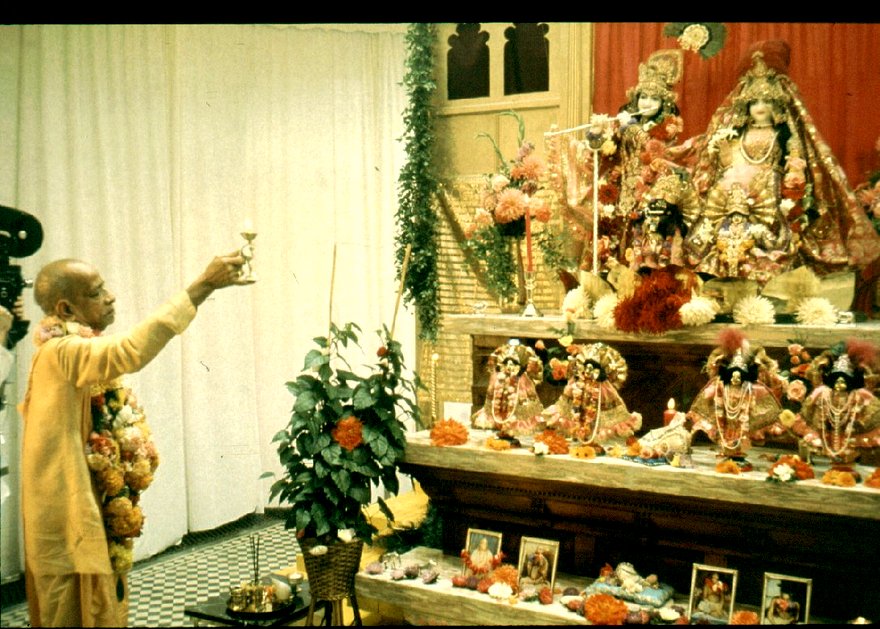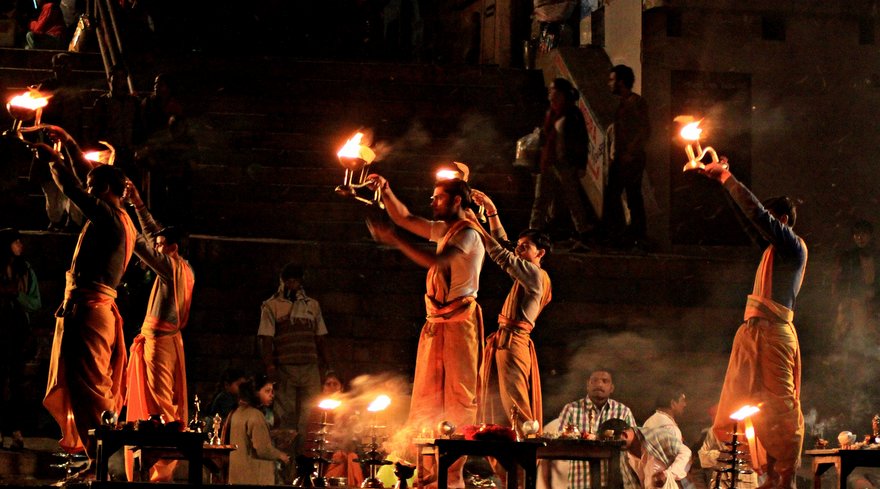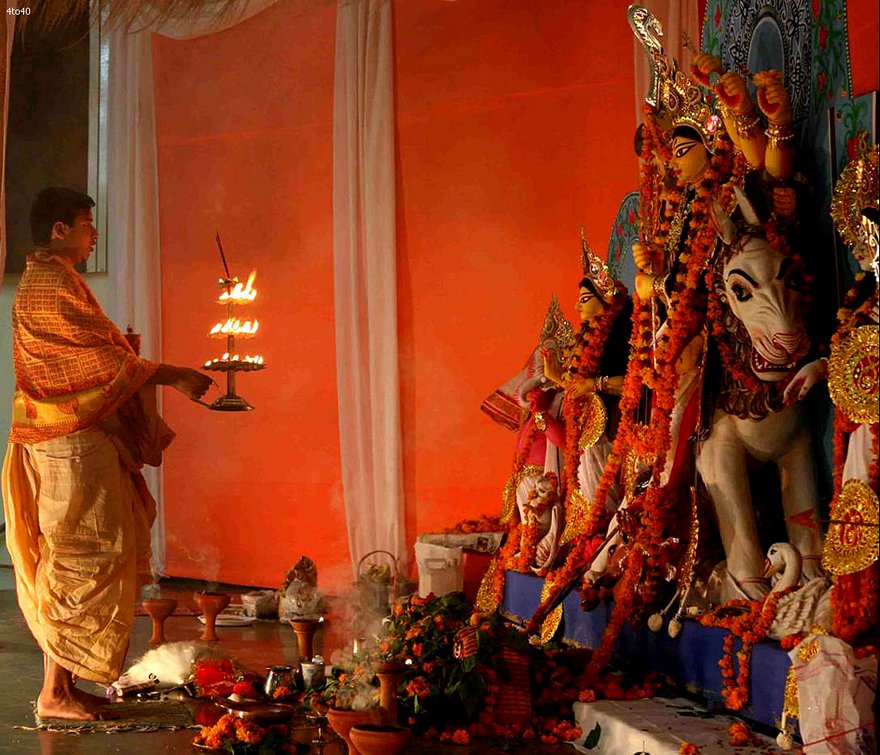Importancia de Aarthi en el hinduismo
Oferta Aarthi significa llamar a Dios con un intenso anhelo. Si un ser humano llama a una deidad a través del medio de la Aarthi continuación, se le concede o bien una visión de Dios en la forma de la luz o de la forma de las deidades.
Los himnos en un Aarthi que están en elogio de las deidades, también conllevan una ferviente oración hecha a Dios para ganar su gracia. Los dioses y Dios que otorga la gracia, están satisfechos con las alabanzas y adoración del único que ofrece Aarthi. Hacia el final de cada culto ritualista (Pooja o bhajans) del Señor o para recibir a un invitado de honor o santo, realizamos la Aarathi. Esto siempre es acompañado por el sonido de la campana y, a veces por cantar, tocar instrumentos musicales y aplausos.
Es uno de los pasos dieciséis (shodasha upachaara) del ritual pooja. Se conoce como la lámpara encendida en la mano derecha, que agitamos en un movimiento de las agujas del reloj en circuito a la luz de toda la forma del Señor.
Cada parte se revela de forma individual y también a toda la forma del Señor. Como thelight es ondulado o nos hacemos canto mental o en voz alta de las oraciones o simplemente contemplar la hermosa forma del Señor, iluminada por la lámpara. Al final de la aarthi ponemos nuestras manos sobre la llama y luego tocar suavemente los ojos y la parte superior de la cabeza.
Después de haber adorado al Señor del amor - la realización de abhisheka, la decoración de la imagen y ofreciendo frutas y manjares, vemos la belleza del Señor en toda su gloria. Nuestras mentes se centran en cada extremidad del Señor como la lámpara se enciende para arriba. Es similar a la meditación en silencio con los ojos abiertos en su belleza. El canto, aplausos, el timbre de la campana etc.denote la alegría y la buena fortuna, que acompaña a la visión del Señor.
Aarthi se realiza a menudo con alcanfor. Esto tiene un significado espiritual diciendo. Alcanfor cuando se enciende, se quema por completo sin dejar un rastro de ella. Representa nuestras tendencias inherentes (vaasanas). Cuando está iluminado por el fuego del conocimiento que ilumina el Señor (Verdad), nuestros vaasanas a partir de entonces se queman por completo, sin dejar un rastro de ego, que crea en nosotros un sentido de individualidad que nos mantiene separados del Señor.
Asimismo, mientras que el alcanfor se quema para revelar la gloria del Señor, que emite un agradable perfume incluso mientras se sacrifica a sí mismo. En nuestro progreso espiritual, así como nosotros servimos al guru y de la sociedad, debemos sacrificar voluntariamente a nosotros mismos y todo lo que tenemos, para difundir el "perfume" de amor a todos. A menudo esperar mucho tiempo para ver al Señor iluminada pero cuando el aarthi se lleva a cabo en realidad, nuestros ojos se cierran automáticamente, como para mirar hacia adentro. Esto es para significar que cada uno de nosotros es un templo del Señor.
Del mismo modo que el cura revela la forma del Señor claramente con la llama aarthi, así también el gurú nos revela la divinidad dentro de cada uno de nosotros con la ayuda de la "llama" del conocimiento (o la luz del conocimiento espiritual). Al final de la aarthi, ponemos nuestras manos sobre la llama y luego se toca los ojos y la parte superior de la cabeza. Esto significa - Que la luz que ilumina el Señor ilumina mi visión; puede ser mi visión divina y mis pensamientos noble y hermoso.
El significado filosófico de aarthi extiende aún más. El sol, luna, estrellas, rayos y el fuego son las fuentes naturales de luz. El Señor es la fuente de este fenómeno wonderous del universo. Esto se debe sólo a Él que todo lo demás existe y brillo. Ya que iluminan al Señor con la llama de la aarthi, dirigimos nuestra atención a la fuente de toda luz, que simboliza el conocimiento y la vida.
También el sol es la deidad que preside el intelecto, la luna, la de la mente, y el fuego, la del habla. El Señor es la conciencia suprema que ilumina todos ellos. Sin él, el intelecto no puede pensar, ni puede sentir la mente ni la lengua habla. El Señor está más allá de la mente, el intelecto y el habla. ¿Cómo puede este equipo finita iluminar el Señor? Por lo tanto, mientras llevamos a cabo la aarthi cantamos;
Ni el mecanismo de Suryo Bati no Chandra Tarkm
Nema Vidyuto transmitir Kutoymgnib
Tmewa Bantm giro sobre ellos Srwn
Tsy Bsa Srwn pasos Vibati
Él está allí donde el sol no brilla,
ni la luna, las estrellas y los rayos.
entonces lo que hablar de esta pequeña llama (en la mano),
todo (en el universo) brilla sólo después de que el Señor,
y por su luz solo estamos todos iluminados.
¿Por qué es Arti realiza dos veces al día?
Arti está destinado a ser realizada al amanecer y al atardecer. Al salir el sol la atmósfera predominante raja-tama presente durante toda la noche se destruye y las frecuencias elemento fuego absolutos de Deidades llegar en el universo. Por lo tanto, Arti se va a ofrecer al amanecer para darles la bienvenida. El 'Tarak Chaitanya' (forma salvador de Chaitanya) transmitida durante la llegada de las frecuencias de Deidades en la salida del sol es para ser recibido por el adorador a través del medio de la Arti, mientras que a la puesta del sol, el Arti se lleva a cabo para destruir la raja-tama frecuencias y para invocar el Deities' 'Marak Chaitanya' (forma destructor de Chaitanya). Por eso Arti se debe realizar dos veces - al amanecer y al atardecer.
¿Cuál es la Ciencia en Realización de Artes en la puesta del sol?
Al atardecer la proporción del elemento fuego absoluta en los rayos del sol comienza la reducción y el predominio de las partículas de raja-tama en la atmósfera aumenta. La generación de frecuencias raja-tama también aumenta. Aprovechando esta situación, las energías negativas aumentan su movimiento en el medio ambiente se. Para evitar la angustia de un entorno de raja-tama tales predominantemente, es esencial para evocar las Deidades a través de las frecuencias de sonido emitidas a través de la Artes y traer estas frecuencias en la órbita del universo. Como resultado, la proporción de las frecuencias de Deidades enriquecida dentro de los incrementos de medio ambiente y la proporción de las vibraciones perturbadoras disminuye. Esto crea una armadura protectora alrededor del cuerpo del devoto.
El Arti debe ser cantado con la bhav que 'Dios mismo está de pie delante y yo estoy llamando a Él con seriedad'.
Cuanto más la bhav tiene al cantar el Arti de Dios, más enriquecido con bhav y sattva predominantes del Arti llegará a ser. Tal Arti llegará al Señor más rápido. Los individuos que cantan una Arti en este beneficio manera como sigue: Cuanto mayor es el bhav colectiva del grupo cantando la Arti, mayor es la extensión y la duración de la preservación de las frecuencias de Chaitanya (conciencia divina) de Deidades en el medio ambiente. Esto conduce a una reducción en la angustia de las energías negativas y obtener el beneficio de Chaitanya.
Cada alma encarnada debe hacer un esfuerzo para llevar a cabo el Arti con bhav. También como una cubierta está formada en el suelo por estas vibraciones predominantes sattva (que detiene la transmisión de frecuencias perturbadoras de las regiones sutiles negativas), alma encarnada del adorador más se beneficia de la Chaitanya. Así, durante el Arti cuerpos densos y sutiles del adorador se purifican y los resultados en su evolución más rápida espiritual.
En agitando el plato Arti frente a una deidad ¿Por qué un plato de Aarthi ser agitada en un círculo completo en frente de la Deidad?
Al ofrecer Arti, utilizando una lámpara con cinco mechas (también llamado pancharti), el plato que contiene esta lámpara encendida debe agitó en un círculo completo en frente de la Deidad. Esto se traduce en un movimiento circular rápido de frecuencias sattva emitidos por la llama de la lámpara. Estas frecuencias sattva luego se convierten poco a poco en las frecuencias raja. Aparecen como ondas en el agua.
A Kavach Suraksha (armadura de protección) de estas frecuencias se forma alrededor del alma encarnada del adorador ofreciendo la Arti y se conoce como un 'tarang Kavach' (lit. 'ondulación armadura'). Cuanto más la emoción espiritual del adorador ofrece el Arti, ya esta armadura dura. Como su componente sattva se ve reforzada, que es capaz de absorber las frecuencias más divina del universo. Esto aumenta su emoción espiritual y que percibe el reflejo de su alma en forma de una mancha azul de la luz (también conocido como Atmabindu) delante de él y una onda de frecuencias raja emanan de esta Atmabindu.
¿Por qué el plato Aarthi sea agitado, en el sentido del reloj delante de la Deidad?
Como la tierra se mueve en la dirección de las agujas del reloj, las frecuencias en el medio ambiente no ofrecen ninguna resistencia al movimiento de la lámpara encendida.
¿Por qué el plato Arti no se movió por encima de la cabeza de la Deidad?
El plato Aarthi no debe ser un gesto por encima de la cabeza de la deidad, pero debe ser movido desde el Anahata Chakra Agya a la de la deidad. Debido a la influencia de las frecuencias raja que emanan de la Arti, la fricción se desarrolla con las partículas sattva en las frecuencias serenos relacionadas con el principio divina no manifiesto (emitida desde la cabeza de la deidad). Como resultado, pueden desintegrarse antes de ser transmitida.
Es por ello que el plato Arti no debe ser un gesto por encima de la cabeza de la deidad. Por lo tanto, las frecuencias de alta velocidad emitidos desde el chakra Adnya y que están relacionados con los atributos de la Deidad conseguir complementadas por las frecuencias raja que emanan de la lámpara de los Arti. Esto les permite transmitir eficazmente en el entorno de la formación de una armadura de protección alrededor de los fieles y la destrucción de la raja-tama en el medio ambiente.
El plato Arti no debe ser un gesto por encima de la cabeza de la deidad, pero debe ser movido desde la a la de la deidad. Debido a la influencia de las frecuencias que emanan de la, la fricción se desarrolla con las partículas en las frecuencias serenos relacionadas con el principio divina no manifiesto (emitida desde la cabeza de la deidad). Como resultado, pueden desintegrarse antes de ser transmitida. Es por ello que el plato Arti no debe ser un gesto por encima de la cabeza de la deidad. Por lo tanto, las frecuencias de alta velocidad emitidos desde el y que están relacionados con los atributos de la Deidad conseguir complementadas por las frecuencias raja que emanan de la lámpara de la. Esto les permite transmitir eficazmente en el entorno de la formación de una armadura de protección alrededor de los fieles y la destrucción de la raja-tama en el medio ambiente.
Fuente: bharathkidilse.blogspot.in
Importance of Aarthi in Hinduism
Offering Aarthi means calling out to God with intense yearning. If a human being calls out to a deity through the medium of the Aarthi then he is granted either a vision of God in the form of light or of the deities' form.
The hymns in an Aarthi which are in praise of the deities, also entail an earnest prayer made unto God to win His grace. The deities and God who bestows grace, are pleased with the praises and worship of the one who offers Aarthi. Towards the end of every ritualistic worship (pooja or bhajan) of the Lord or to welcome an honored guest or saint, we perform the Aarathi. This is always accompanied by the ringing of the bell and sometimes by singing, playing of musical instruments and clapping.
It is one of the sixteen steps (shodasha upachaara) of the pooja ritual. It is referred to as the lighted lamp in the right hand, which we wave in a clockwise circling movement to light the entire form of the Lord.
Each part is revealed individually and also the entire form of the Lord. As thelight is waved we either do mental or loud chanting of prayers or simply behold the beautiful form of the Lord, illumined by the lamp. At the end of the aarthi we place our hands over the flame and then gently touch our eyes and the top of the head.
Having worshipped the Lord of love – performing abhisheka, decorating the image and offering fruits and delicacies, we see the beauty of the Lord in all His glory. Our minds are focused on each limb of the Lord as the lamp lights it up. It is akin to silent open-eyed meditation on His beauty. The singing, clapping, ringing of the bell etc.denote the joy and auspiciousness, which accompanies the vision of the Lord.
Aarthi is often performed with camphor. This holds a telling spiritual significance. Camphor when lit, burns itself out completely without leaving a trace of it. It represents our inherent tendencies (vaasanas). When lit by the fire of knowledge which illumines the Lord (Truth), our vaasanas thereafter burn themselves out completely, not leaving a trace of ego which creates in us a sense of individuality that keeps us separate from the Lord.
Also while camphor burns to reveal the glory of Lord, it emits a pleasant perfume even while it sacrifices itself. In our spiritual progress, even as we serve the guru and society, we should willingly sacrifice ourselves and all we have, to spread the "perfume" of love to all. We often wait a long while to see the illumined Lord but when the aarthi is actually performed, our eyes close automatically as if to look within. This is to signify that each of us is a temple of the Lord.
Just as the priest reveals the form of the Lord clearly with the aarthi flame, so too the guru reveals to us the divinity within each of us with the help of the "flame" of knowledge (or the light of spiritual knowledge). At the end of the aarthi, we place our hands over the flame and then touch our eyes and the top of the head. It means – may the light that illuminated the Lord light up my vision; may my vision be divine and my thoughts noble and beautiful.
The philosophical meaning of aarthi extends further. The sun, moon, stars, lightning and fire are the natural sources of light. The Lord is the source of this wonderous phenomenon of the universe. It is due to Him alone that all else exist and shine. As we light up the Lord with the flame of the aarthi, we turn our attention to the very source of all light, which symbolizes knowledge and life.
Also the sun is the presiding deity of the intellect, the moon, that of the mind, and fire, that of speech. The Lord is the supreme consciousness that illuminates all of them. Without Him, the intellect cannot think, nor can the mind feel nor the tongue speaks. The Lord is beyond the mind, intellect and speech. How can this finite equipment illuminate the Lord? Therefore, as we perform the aarthi we chant;
Na tatra suryo bhaati na chandra taarakam
Nemaa vidyuto bhaanti kutoyamagnib
Tameva bhaantam anubhaati sarvam
Tasya bhasa sarvam idam vibhaati
He is there where the sun does not shine,
Nor the moon, stars and lightning.
then what to talk of this small flame (in my hand),
Everything (in the universe) shines only after the Lord,
And by His light alone are we all illumined.
Why is Arti Performed Twice a Day?
Arti is meant to be performed at sunrise and sunset. At sunrise the raja-tama predominant atmosphere present throughout the night is destroyed and the absolute fire element frequencies of Deities arrive in the universe. Hence, Arti is to be offered at sunrise to welcome them. The 'tarak Chaitanya' (saviour form of Chaitanya) transmitted during the arrival of the frequencies of Deities at sunrise is to be welcomed by the worshipper through the medium of the Arti, whereas at sunset, the Arti is performed to destroy the raja-tama frequencies and to invoke the Deities' 'marak Chaitanya' (destroyer form of Chaitanya). That is why Arti should be performed twice – at sunrise and at sunset.
What is the Science in Performing Arti at Sunset?
At sunset the proportion of the absolute fire element in the Sun's rays starts reducing and the predominance of the raja-tama particles in the atmosphere increases. The generation of raja-tama frequencies also increases. Taking advantage of this situation, the negative energies increase their movement in the environ-ment. To prevent distress from such a predominately raja-tama environment, it is essential to evoke the Deities through the frequencies of sound emitted through the Arti and bring these frequencies into the orbit of the universe. As a result the proportion of the frequencies of Deities enriched within the environment increases and the proportion of distressing vibrations decreases. This creates protective armour around the devotee's body.
The Arti should be sung with the bhav that 'God Himself is standing in front and I am calling out to Him earnestly'.
The more the bhav one has while singing the Arti for God, the more enriched with bhav and sattva predominant the Arti will become. Such an Arti will reach the Lord faster. Individuals singing an Arti in this manner benefit as follows: The greater the collective bhav of the group singing the Arti, greater is the extent and period of preservation of the frequencies of Chaitanya (Divine consciousness) of Deities in the environment. This leads to a reduction in the distress from negative energies and gaining the benefit of Chaitanya.
Every embodied soul should make an effort to perform the Arti with bhav. Also as a covering is formed on the ground by these sattva predominant vibrations (which stops the transmission of distressing frequencies from the Negative subtle regions), the worshipper's embodied soul benefits most from the Chaitanya. Thus during the Arti the worshipper's gross and subtle bodies get purified and results in his faster spiritual evolution.
On waving the Arti platter in front of a Deity Why should an Aarthi platter be Waved in a full Circle in front of the Deity?
When offering Arti, using a lamp with five wicks (also called pancharti), the platter containing this lit lamp should be waved in a full circle in front of the Deity. This results in a speedy circular movement of sattva frequencies emitted by the flame of the lamp. These sattva frequencies then get converted gradually into raja frequencies. They appear like ripples in the water.
A suraksha kavach (protective armour) of these frequencies is formed around the embodied soul of the worshipper offering the Arti and is known as a 'tarang kavach' (lit. 'ripple armour'). The more the spiritual emotion of the worshipper offering the Arti, longer this armour lasts. As his sattva component is enhanced, he is able to absorb more Divine frequencies from the Universe. This increases his spiritual emotion and he perceives the reflection of his soul in the form of a blue spot of light (also known as Atmabindu) in front of him and a ripple of raja frequencies emanating from this Atmabindu.
Why should the Aarthi platter be Waved in a Clockwise Direction in Front of the Deity?
As the earth moves in the clockwise direction, the frequencies in the environment do not offer any resistance to the movement of the lit lamp.
Why should the Arti platter not be waved above the head of the Deity?
The Aarthi platter should not be waved above the head of the Deity, but should be moved from the Anahata to the Agya Chakra of the Deity. Due to the influence of the raja frequencies emanating from the Arti, friction develops with the sattva particles in the serene frequencies related to the unmanifest Divine principle (emitted from the head of the Deity). As a result, they can disintegrate before being transmitted.
That is why the Arti platter should not be waved above the head of the Deity. Thus, the high-speed frequencies emitted from the Adnya chakra and which are related to the attributes of the Deity get complemented by the raja frequencies emanating from the lamp of the Arti. This enables them to be transmitted effectively in the environment forming a protective armour around the worshippers and destroying the raja-tama in the environment.
The Arti platter should not be waved above the head of the Deity, but should be moved from the to the of the Deity. Due to the influence of the frequencies emanating from the , friction develops with the particles in the serene frequencies related to the unmanifest Divine principle (emitted from the head of the Deity). As a result, they can disintegrate before being transmitted. That is why the Arti platter should not be waved above the head of the Deity. Thus, the high-speed frequencies emitted from the and which are related to the attributes of the Deity get complemented by the raja frequencies emanating from the lamp of the . This enables them to be transmitted effectively in the environment forming a protective armour around the worshippers and destroying the raja-tama in the environment.
Source: bharathkidilse.blogspot.in






